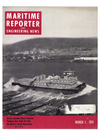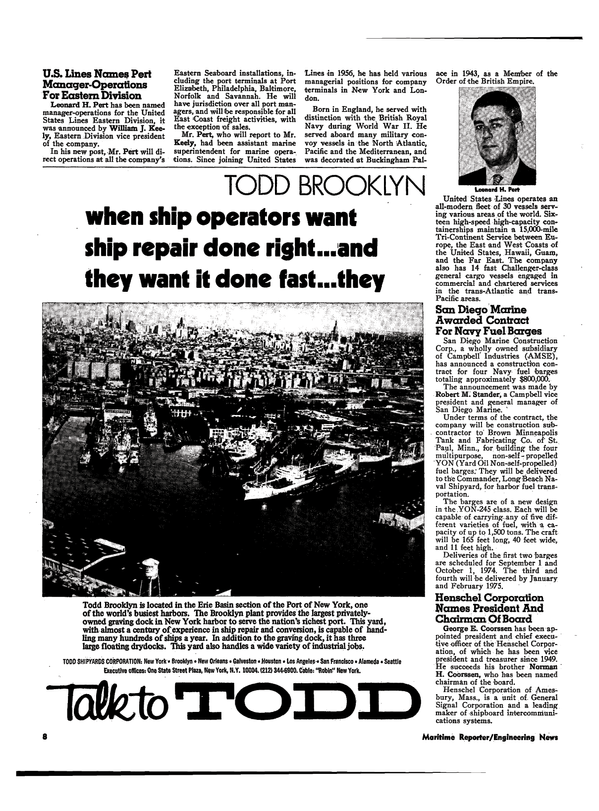
Dravo Corporation Launches Most Powerful Towboat For Use On World's Inland Waterways
Dravo Corporation recently launched the most powerful towboat ever .built for use on the world's inland waterways.
Splashing into the Ohio River on January 31 at the company's Neville Island shipyard near Pittsburgh, Pa., the 10,100-horsepower vessel will join the fleet of The Valley Line Company, St. Louis, Mo., a subsidiary of Chromalloy American Corporation.
Thomas J. Barta, Valley Line president, said the towboat will begin operating early this spring, handling 40-barge tows of approximately 50,000 tons. Principal cargoes will include coal, s'teel, ores and grain.
The new boat will operate on the Mississippi River, between St. Louis and New Orleans, La.
With the addition of this first-of-its-power vessel, Valley Line's fleet totals 21 towboats and 750 barges. The company is one of the largest operating on the country's rivers and coastal waterways.
Powered by three General Motors marine diesel engines—each rated at 3,367 horsepower —the new boat measures 190 by 54 by 12^4 feet. It will 'be driven by three 10-foot-diameter five-bladed stainless steel propellers, housed in Kort nozzles.
The vessel has the latest safety and pollution Final construction view of the 10,100-hp towboat which will handle 40-barge tows of approximately 50,000 tons.
Cargoes will include coal, steel, ores and grain.
control equipment, including inboard fuel bunkers to protect against river contamination in the event of a side puncture.
Control features of the towboat will include devices for automatic transfer of generator load; remote-reading instruments and alarms for monitoring engine performance ; and remote controls for fuel bunkering and transfer, and bilge pumping.
Propulsion and maneuvering will be completely controlled from the pilothouse, which is also equipped with radar, ship-to-shore telephone, depth finder, autopilot with standby steering system, other modern navigational aids, and remote deck winch controls.
Pilothouse, quarters and mess facilities will be air-conditioned.
The welded steel hull is compartmented into five watertight areas: fore peak ballast tank, fuel bunkers and wing ballast tanks, machinery space, shaft alley and aft void space.
Steel superstructure consists of a main deckhouse, an upper deckhouse, an electronics space and a pilothouse.
The remote-controlled operating equipment will include: Modified VHF radio for use as a mobile telephone; another VHF radio for lock corn- munication ; and single-hand radiotelephone for intra-company use.
Deck winch controls located in the pilotbouse.
Radar, gyro and repeaters, Fathometer and automatic pilot steering.
Diesel engine monitoring system with visual and audible alarms in push-button controlled air-conditioned engine control room, in the pilothouse and in the chief engineer's quarters.
Lighter schematic panels in engine control room to show condition of fuel oil, bilge pumping and ballast water systems. Remote pump and valve controls for fuel transfer and pumping bilges will be mounted in these panels.
Automatic generator load transfer system and alarms.
General alarm system of bells in crew's quarters, officers' quarters hallway, aft upper engine room, forward lower engine room and galley.
The heating-cooling system for living quarters will employ water from a 500,000 BTU oil-fired boiler or cooling water from a liquid cooler. Air-conditioning and heating systems are designed to maintain optimum temperatures in living areas. A forced ventilation system will 'supply positive pressure in the engine room. Engine air will be supplied directly from the outside.
Read Dravo Corporation Launches Most Powerful Towboat For Use On World's Inland Waterways in Pdf, Flash or Html5 edition of March 1974 Maritime Reporter
Other stories from March 1974 issue
Content
- Shallow-Draft Bulk Carrier Study Award To M. Rosenblatt page: 4
- Naval Hydrodynamics Symposium To Be Held At M.I.T. June 24-28 page: 4
- Dravo Corporation Launches Most Powerful Towboat For Use On World's Inland Waterways page: 6
- U.S. Lines Names Pert Manager-Operations For Eastern Division page: 8
- $40-Million Contract To Nashville Bridge For Towboats, Barges page: 10
- Nathan Friedland loins Santa Fe Engineering page: 10
- Todd Appoints Stuart Jones To Head New Tanker Planning page: 11
- Todd Shipyards Los Angeles Division To Build Four 89,700-Dwt Tankers At A Total Cost Of $136 Million page: 11
- Officers Named By Johnston Pump Company page: 11
- AML And APL Announce Changes Of Key Personnel page: 12
- Ingram Signs 10-Year $150-Million Contract To Transport Fuel Oil page: 13
- Three Appointments To Towing Industry Advisory Committee page: 13
- Alaska Pipeline Background Information -Tankers Required To Cost $1.6 Billion page: 14
- Minneapolis Investors Acquire Grafton Boat page: 14
- First Phase Of New Keppel Subsidiary, Tuas Shipyard, To Cost $70 Million —A Number Of Key Appointments Made page: 17
- Long-Term Charters Planned By Sohio page: 17
- Finnish Passenger Ship To Be Powered By Turbo Power & Marine Systems Gas Turbines page: 17
- Universal Gas & Oil To Sell LPG Carrier For $32.5 Million page: 18
- Harold Reinauer Named Vice President AWO Region Five page: 22
- Adm. Healey, USN (Ret.) Joins EDO Corporation page: 23
- Study Indicates U.S. Waterborne Trade To Triple By Year 2000 page: 26
- Lufkin Announces Three Appointments page: 27
- New Pacific Coast Shipping Association Invites Membership page: 28
- COMSAT General Corp. Names David W. King page: 28
- Moore And McCormack Changes Firm Name— Earnings Increased page: 32
- American Export Lines Agrees To Sell Two Passenger Vessels page: 33
- Stork-Werkspoor Receive Orders For 32 Engines page: 33
- ASME Marine Committee To Present Thirteen Papers At Zurich Gas Turbine Conference page: 34
- Dearborn-Storm To Concentrate On Offshore Drilling Industry —Computer Leasing To Be Sold page: 35
- B&W To Supply Six Marine Boilers For Three Merchant Ships page: 36
- C.J. Hendry Co. Appoints John Iamarino page: 36
- Waterways Attract 87 Plant Facilities In Last Quarter 73 page: 37
- Liffey Marine Operating New Supply Vessel Designed To Carry A Wide Variety Of Cargo page: 38
- AAPA Committee Names John Finnegan page: 39
- Soviet Trading Firm Takes Space In N.Y/s World Trade Center page: 39
- A.L. Burbank Forms Shipcentral, Limited —Tsao Named To Board page: 40
- Colt Industries To Build Fairbanks Morse Diesels To Power ODECO's Ocean Ranger page: 42
- Insley Yard Delivers Tug To Great Lakes Dredge & Dock page: 42
- British Ocean Group Forms New Shipbroking Company page: 43
- Kings Point Alumni Opposes Committee Dismemberment page: 43
- Engelhard To Provide Cathodic Protection For 16 Navy Destroyers page: 44
- Northen Of ACT/PACE Elected CI President page: 44
- Campbell Launches 18th In Series Of Tuna Superseiners page: 45
- Rule Changes By Lloyd's Register page: 49
- Carrington Slipways Builds Fleet Of Eight Supply Vessels For Australian Offshore page: 50
- 60% Of Spanish-Built Ships Built By Astilleros Espanoles —Spain Now In Fourth Place page: 50


